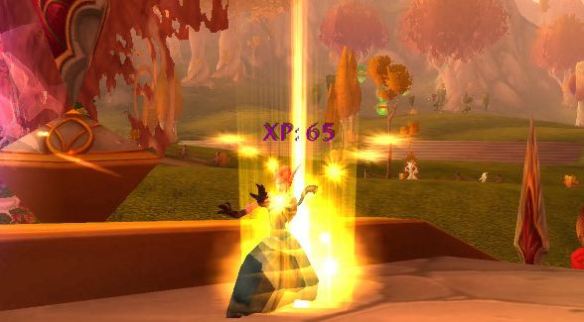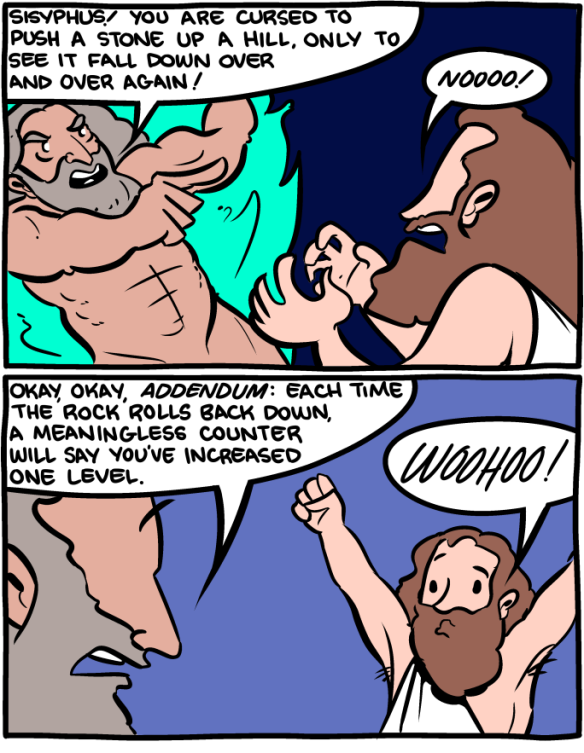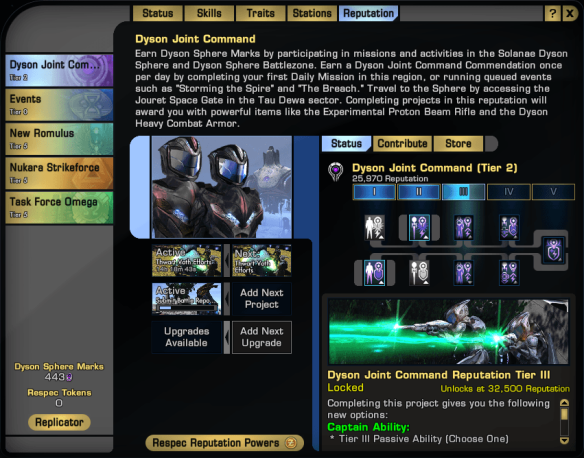I had an old friend from Montreal,
Who tended to the vampirical.
But I should have figured,
When he explained he preferred
His Bloody Marys quite literal.
Monthly Archives: March 2014
The Existential Crisis of Leveling Up
Ding! Level Up!
For those who play RPG video games, whether from the days of Everquest or their more modern incarnations such as World of Warcraft, Diablo, Guild Wars or Star Trek Online, the one almost ubiquitous commonality is the concept of leveling up.
You know the experience. You’re beating up some poor, innocent rat or goblin, and as each victim of your mayhem falls beneath your feet you can see the experience point bar creep up…up…up until finally, at last, in a shower of light and triumphant crescendo you achieve that coveted accomplishment – the next level.
You get more hit points, perhaps. Maybe a new spell that does more damage, or perhaps simply the ability to slot a weapon or piece of gear that will give you one of those things.
And, truth be told, it feels good. You genuinely feel like you’ve hit a milestone, like a congressman who wins an election for the U.S. Senate or a Masters student who receives their PhD. You’re tougher. You’re better. You’re awesome.
There’s just one problem: It’s (mostly) a lie.
At the same time you’ve gotten better, behind the scenes so did everything else.
Different games handle this a bit differently; most often, the stuff you’ve been murdering by the scores doesn’t get tougher, but you can now go to a new area with new things to kill, and those things are tougher.
It’s true, you can go back to old areas and “feel the power”, and some percentage of players do exactly this, but it’s not like even those players who do go back to visit past battlegrounds actually spend any substantial time there. And, why should they? It’s no longer a challenge, after all.
Even in professional game design circles, this mechanic is usually considered sacrosanct. Despite that it is a relic of pen-and-paper games designed around a human referee and a small handful of players sitting around a table, the leveling mechanic has become something akin to holy writ for the industry.
Objections of the leveling mechanic most often receive a blank stare or, at best an existential protest of, “But what would we replace it with?”
Ultima Online bucked this trend early on, and the first version of Guild Wars flirted heavily with leaving the leveling mechanic behind, but these were outliers that the industry as a whole never embraced, at least not for the mechanic in question.
Progression is important in a video game, but in most games leveling offers more illusion than reality, and as such I would argue it’s at best a placebo (for the sake of literary argument let’s leave aside the fact that the placebo effect actually does have a chemical effect in your brain, but…anyways, back to the subject at hand).
The problem is that when you level up, the player’s experience stays the same. Yes, most games are clever enough to give you a brief period of feeling more powerful in whatever new area you are fighting in, but inevitably the difficulty starts edging up until you are again about where you were: enemies will still be taking more or less the same amount of time to defeat; enemies will still be defeating you in more or less the same number of hits.
There are, to be sure, a number of overlying approaches that can – and are – applied: Enemies may use different (or simply more) mechanics. The overall difficulty may edge up a tad. Players may gain a wider (or at least different) selection of tactical options. From a design point of view, these are genuine points of advancement, but the underlying leveling mechanic tends to overshadow these, meaning that designers rarely feel the need to fully develop these changing mechanics.
Ultimately, there are two questions that have to be answered:
- How does the incoming gameplay change?
- How does the outgoing gameplay change?
Incoming gameplay elements are all the factors that are exterior to the player – does it take longer on average for a player to defeat an enemy? Does the player have less of a margin for error due to enemies doing more damage? Does the gameplay demand a greater degree or player dexterity? Does the player have to track more enemies at the same time? Are the tactics employed by the player’s challenges more widely varying, or simply more difficult?
Outgoing gameplay elements are all the factors that are internal to the player – does the player have more tactical options at his or her disposal? Does the player have more (or better) ways of dealing with (or cheating) defeat? Does the player have additional allies that can be deployed?
Note that damage and health, per se, are not included anywhere above. Yes, there is mention of changes in time to defeat or time to be defeated, but the fact that a “1000” appears above an enemy’s head as opposed to a “900” does not by itself mean anything if all the other numbers are also changing.
In other words, the numbers are an illusion; what deserves to be focused on is the gameplay experience.
Don’t get me wrong – this is really fucking hard. It’s easy to slap a bigger visual effect and an objectively meaningless but psychologically satisfying bigger number on an attack. It’s damned hard to come up with actual new gameplay. It’s even harder to come up enough new gameplay to satisfy players for the length of time games now strive to hold players for.
Because this is really hard, most games lean heavily on psychological tricks to make players feel like they are progressing, even when they aren’t:
- New environments that are visually different.
- Enemies that are graphically different.
- Reputation grinds.
- Larger numbers.
- Carefully timed carrots to give special incentive to log in on sequential days.
Part of this is simply the result of the market. As games have moved to a persistent online model, players are much less likely to play a game for ten or twenty hours and then put it down, but now expect to get hundreds of hours of gameplay out of the same development dollars.
Similarly, the rise of the microtransaction behemoth means that development studios are under increasing pressure to keep players playing – no longer is it enough just to have a snappy marketing plan and a cool TV commercial or great cover art – now you have to deal with the player asking, “Well, what now?”
There are a lot of ways this problem can be approached; I am certainly not going to claim to have the silver bullet. Hell, if there was a silver bullet, someone would have found it by now – there are an enormous number of very smart people in the industry.
One possible line of inquiry might simply be to break down the walls between gameplay aspects traditionally viewed as content and aspects traditionally viewed as systems. Guild Wars and Skyrim both represent philosophical efforts in this direction, whether or not the studios in question were conscious of this.
Another – kind of scary – approach would be to start asking some dangerous questions: If the gameplay from, say, Level 1 to the level cap is essentially a completely different gameplay than the “End game” of raids or PvP or whatever, perhaps the solution is to simply do away with the former and make your entire game consist of the latter. Yes, this will require the solving of some very tricky problems, but it would serve to, perhaps, at last start to move the industry past this trap of illusionary advancement that ultimately serves neither players nor developers.
Comic credit to Saturday Morning Breakfast Cereal. Check them out. They’re awesome.




